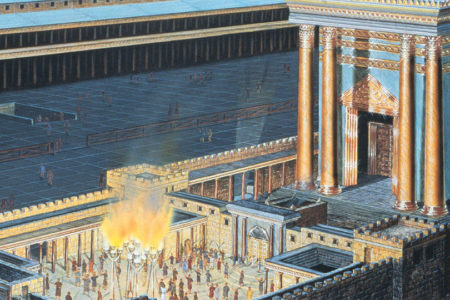Three Appearings of the Messiah
The recently divulged discovery of life on Mars captivated the attention of much of the world. With the first announcement, there was a rush of anticipation fueled by visions of little green men careening through outer space in saucer-shaped vehicles. The usual speculation was soon upon us, fostering the idea that we are not alone in the universe and that perhaps, at long last, we will discover the elusive key to the origins of creation. But, alas, lurking behind the headlines were no green men from the Martian diplomatic corps here to extend the hand of friendship to awe-smitten earthlings. No, just some tiny bacteria discovered in the remains of a meteorite that had been laying around in Antarctica for a few thousand years. No one was sure that the rock actually came from Mars, but it was probable enough, in some scientific minds, to warrant the spectacular announcement.
The excitement generated by this discovery in the scientific community and the public at large was but one more manifestation of the natural man’s craving to find an explanation other than the one found in Genesis 1:1: “In the beginning God created the heaven and the earth.” We can be sure that the search will continue unabated, and every new tabloid-style “breakthrough” will send millions rushing to their supermarket newsstands. In the final analysis, however, the search will be futile—mankind will never be able to break free from God.
The Real Story
Behind all of the humanly devised hype and headlines is a simple affirmation of the truth—a truth generated by a far superior source: divine revelation confirmed by irrefutable evidence.
In addition to Genesis 1:1, which is profoundly eloquent in its simplicity, hundreds of biblical quotations are related to the creation of the universe by a direct act of God. For me, one passage—Hebrews 1:1–3—combines the elements that give us, in understandable terms, the entire story. Three elements of the divine program for the ages are found in these verses.
- God has revealed Himself and His Son through the Scriptures: “God, who at sundry times and in diverse manners spoke in time past unto the fathers by the prophets, Hath in these last days spoken unto us by his Son.”
- The Son spoke the universe into existence: “by whom also he made the worlds.”
- Deity invaded humanity through the incarnation to meet humanity’s most basic need, redemption: “when he had by himself purged our sins, sat down on the right hand of the Majesty on high.”
The Son’s Appearance Through the Scriptures
When, deep in the month of December, Christian believers the world over join their voices to sing “O little town of Bethlehem,” they are reminding us of indelible links to prophetic history. Bethlehem was the location where the prophesied entry of the Messiah was to take place.
“But thou, Bethlehem Ephrathah, though thou be little among the thousands of Judah, yet out of thee shall he come forth unto me that is to be ruler in Israel, whose goings forth have been from of old, from everlasting” (Mic. 5:2).
In a sense, this verse is the taproot from which all of the 333 Old Testament prophecies concerning the Messiah’s coming grow. The place of the Messiah’s birth, the position He would assume, His preexistence, and His deity are all found here. In fact, the intricacy of detail about the coming Messiah woven throughout the Old Testament makes it impossible, upon honest examination, to doubt the manner and purpose of His appearance. Furthermore, comparing the Scriptures to the life and ministry of Jesus of Nazareth confirms conclusively that the Messiah of the Old Testament prophecies appeared when Mary gave birth to the infant Jesus in Bethlehem-Judah. This is one of the great affirmations of the inerrancy of the Word of God.
Dr. A. T. Pierson in his book, Many Infallible Proofs, makes a telling statement: “There would be no honest infidel in the world were messianic prophecy studied…nor would there be any doubting disciples if this fact of prediction and fulfillment were fully understood.”
The challenge of Jesus to the doubters of His day still applies.
“Search the scriptures; for in them ye think ye have eternal life; and they are they which testify of me” (Jn. 5:39).
The Son’s Appearance in the Creation
A well-known Bible teacher is fond of saying that when Jesus was born in Bethlehem, “God invaded humanity.” It is true. And evidence abounds that He “[upholds] all things by the word of his power.”
During His earthly ministry, before hundreds, indeed thousands of credible witnesses, Jesus commanded what He had created. An obvious example was the calming of the turbulent Sea of Galilee with three words: “Peace, be still” (Mk. 4:39). His disciples, seasoned men of the sea, recognized the unlikelihood of anyone commanding the elements unless He possessed powers beyond their comprehension.
“And they… said one to another, What manner of man is this, that even the wind and the sea obey him?” (Mk. 4:41).
The greatest evidence of His control of the creation was His ability to call people from the grave. Three specific examples are given: the widow’s son at Nain (Lk. 7:11–15), Jairus’ daughter at Capernaum (Mk. 5:21–24, 34–42), and Lazarus at Bethany (Jn. 11:1–44). All were demonstrably dead. In the case of Lazarus, he had been deceased for a full four days before he was awakened by the words, “Lazarus, come forth” (Jn. 11:43).
Among the credible witnesses to the stupendous miracles were the avowed enemies of the Messiah. Thus, if one tends to brush aside such stores from Jesus’ disciples, he is constrained to consider statements by Jesus’ enemies who also certified the event. When, in the aftermath of Lazarus’ resurrection, the leaders of the Temple were discussing how they could bring about Jesus’ death, they made a fascinating admission.
“But the chief priests consulted that they might put Lazarus also to death, Because, by reason of him, many of the Jews went away, and believed on Jesus” (Jn. 12:10–11).
In actuality, the calling forth of Lazarus was only an exclamation point before the bodily resurrection of Jesus Himself. Commanding death to leave His presence after three days in the tomb was the capstone atop the pillar of confirmation of deity presented in His supernatural command of His creation. The early revelation before the garden tomb to the disciples was emphatic: “He is not here,” they were told, “for he is risen, as he said. Come, see the place where the Lord lay” (Mt. 28:6). They were seeking Him in the wrong place. In the wake of the initial revelation came the testimony of more than five hundred credible witnesses who saw the risen Christ.
“And that he was seen of Cephas, then of the twelve. After that, he was seen of above five hundred brethren at once” (1 Cor. 15:5–6).
Perhaps a phrase from the Book of Romans is a fitting summary.
“For the invisible things of him from the creation of the world are clearly seen, being understood by the things that are made, even his eternal power and Godhead, so that they are without excuse” (Rom. 1:20).
This being true, how much more accountable are those who have been exposed to the revelation of the Creator in the person of Christ and His gospel?
The Son’s Appearance to Redeem the Lost
For me, the great wonder of the incarnation is not found in the fact that God limited Himself to a human body and entered time. The wonder to me is why He did it. He came to a planet filled with willful people, the vast majority of whom were disposed to reject Him and the Father who sent Him. Indeed, among the great imponderables is the fact that “He came unto his own, and his own received him not” (Jn. 1:11).
He came to die.
He stated the intention in His first address to the men assembled at the little synagogue in Nazareth.
“The Spirit of the Lord is upon me, because he hath anointed me to preach the gospel to the poor; he hath sent me to heal the brokenhearted, to preach deliverance to the captives, and recovering of sight to the blind, to set at liberty them that are bruised” (Lk. 4:18).
Jesus would “set at liberty them that are bruised” by bearing their stripes Himself on the cross. His being “bruised” is directly related to Isaiah 53:5, which tells us that “he was bruised for our iniquities.” That is, Jesus suffered for our sins in order to pay a price that would redeem all those who would believe in Him. The summary purpose of His coming to earth to die is found in Hebrews 2:14–15:
Forasmuch, then, as the children are partakers of flesh and blood, he also himself likewise took part of the same, that through death he might destroy him that had the power of death, that is, the devil, And deliver them who, through fear of death, were all their lifetime subject to bondage.
So, as we gather once again to sing of Bethlehem, Mary and Joseph, wondering shepherds, and the swaddled Babe in a manger, let’s include another lyric: “Jesus paid it all, All to Him I owe; Sin had left a crimson stain, He washed it white as snow.”








